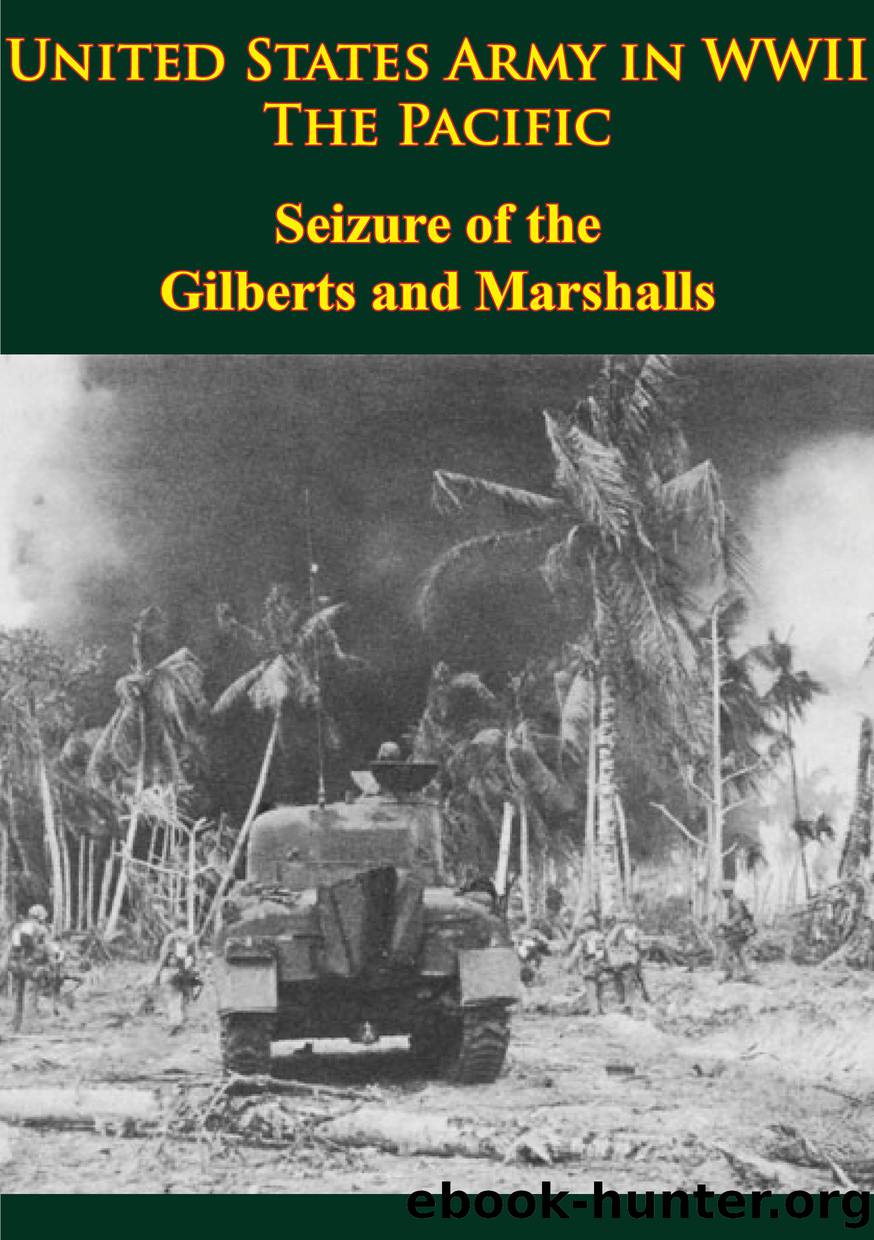United States Army in WWII - the Pacific - Seizure of the Gilberts and Marshalls by Crowl Philip A.;Love Edmund G.;

Author:Crowl, Philip A.;Love, Edmund G.;
Language: eng
Format: epub
Publisher: Verdun Press
Published: 2016-08-24T00:00:00+00:00
From Pearl Harbor to the Eve of Invasion of the Marshalls
The period from the beginning of the war to the middle of 1943 saw considerable expansion of the 6th Base Force. Wake, after its seizure, was placed under 6th Base Force command and extensively developed the Japanese position in the southeast posed a threat to the island garrisons of the Central Pacific, which were considered too weak to ward off American attack. The Japanese responded by drawing Army units from the Philippines, Manchuria, and the homeland and dispatching them to the Central Pacific.{635}
By the end of August 1943 the Japanese position in the Southeastern Pacific Area was such that all thought of offensive operations had to be abandoned. The surrender of Italy on 8 September was a further blow to the Japanese Empire, for it was felt that a powerful portion of the British fleet would be freed to bring pressure on the Indian Ocean front. Until this time, the Japanese defense perimeter had run through the Marshalls, Gilberts, the Southeastern Pacific Area, the Netherlands Indies, and Burma. Now the Solomons and New Guinea were cracking, exposing the Gilberts and Marshalls to the ever-increasing danger of American attack. Hence, the old defensive perimeter had to be abandoned and a new one erected in its place. On 15 September Imperial General Headquarters decided to contract the perimeter to a line running from the Banda Sea through the Carolines and Marianas. The new line was to be made impregnable to American assault during the time gained by delaying actions in the Marshalls and Gilberts, and in the Japanese Southeastern Pacific Area. Thus, these areas were written off as a loss as early as September, but the Japanese were determined to make the American advance toward their new perimeter as costly as possible in order to gain time and wear down the American will to fight. It was in accordance with this strategic concept of fighting a delaying action in the Marshalls that Imperial General Headquarters decided to send large numbers of Army reinforcements there in September 1943.{636}
Army units in Japan, the Philippines, and Manchuria were reorganized as amphibious brigades and South Seas detachments, and dispatched to the Central Pacific as fast as possible.{637} Even though the Marshalls had been written off as indefensible from the long-range point of view, they received a considerable share of the Army reinforcements because of the Japanese intention to conduct strong delaying actions there. The troops were distributed mostly on the peripheryâon the atolls and islands of Wake, Eniwetok, Kusaie, and Mille. Kwajalein, Jaluit, Maloelap, and Wotje already had sizable garrisons, while those on the peripheral islands, except Wake, had been previously quite small.
By January of 1944 Army troops in the Marshalls, Wake, and Kusaie totaled 13,721. The units involved were the 1st South Seas Detachment; the 1st Amphibious Brigade, A Detachment; the 2d South Seas Detachment; and the 3d South Seas Garrison Detachment. They were distributed among the islands and atolls as follows: Kwajalein, 933; Jaluit, 620; Maloelap, 404; Wotje, 667; Mille, 2,530; Eniwetok, 2,586; Wake, 2,050; and Kusaie, 3,931.
Download
This site does not store any files on its server. We only index and link to content provided by other sites. Please contact the content providers to delete copyright contents if any and email us, we'll remove relevant links or contents immediately.
| Central Asia | Southeast Asia |
| China | Hong Kong |
| India | Japan |
| Korea | Pakistan |
| Philippines | Russia |
The Rape of Nanking by Iris Chang(3518)
The Sympathizer by Viet Thanh Nguyen(3487)
World without end by Ken Follett(3008)
Ants Among Elephants by Sujatha Gidla(2925)
Blood and Sand by Alex Von Tunzelmann(2610)
Japanese Design by Patricia J. Graham(2557)
City of Djinns: a year in Delhi by William Dalrymple(2137)
Inglorious Empire by Shashi Tharoor(2102)
Foreign Devils on the Silk Road: The Search for the Lost Treasures of Central Asia by Peter Hopkirk(2056)
In Order to Live: A North Korean Girl's Journey to Freedom by Yeonmi Park(2055)
Tokyo by Rob Goss(2018)
India's Ancient Past by R.S. Sharma(1988)
India's biggest cover-up by Dhar Anuj(1985)
The Great Game: On Secret Service in High Asia by Peter Hopkirk(1962)
Tokyo Geek's Guide: Manga, Anime, Gaming, Cosplay, Toys, Idols & More - The Ultimate Guide to Japan's Otaku Culture by Simone Gianni(1947)
Goodbye Madame Butterfly(1937)
The Queen of Nothing by Holly Black(1757)
Living Silence in Burma by Christina Fink(1731)
Batik by Rudolf Smend(1722)
